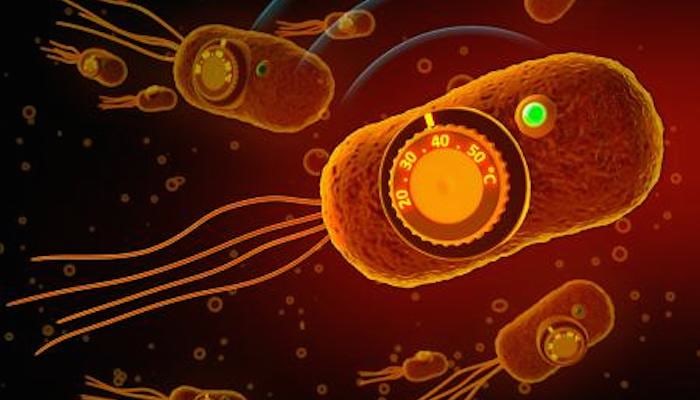Scientists have created a thermal switch for bacteria to control the delivery of drugs

Barth van rossum
A new study by Caltech suggests using genetically modified bacteria to control temperature. They will deliver the medicine to the right organ and then self-destruct. Presumably, this technology will help fight cancer and other diseases.
Microbes have once been tested for their ability to fight disease. But being sent to the body without a sufficiently clear goal, they are, as a rule, not only at the site of the tumor, but also in other organs. If bacteria release the drug in the wrong part of the body, treatment may be ineffective or entail negative side effects.
')
An experiment in mice has shown that physicians can control therapeutic microbes developed in the laboratory. If bacteria are introduced to a patient, then in theory they can only deliver medicine to the damaged organ. In order for the microbes to "understand" which organ to deliver the medicine, the doctors gently heat the organ tissues with ultrasound.
 Bacteria can act as special disease control agents in our bodies. As stated by Associate Professor of Chemical Engineering at the California Institute of Technology and lead author of the study, Mikhail Shapiro, he and his team are working to create a “walkie-talkie” so that you can listen and speak with microorganisms. The main goal of the scientist is to create new ways to control and visualize bacterial and human cells for medicinal purposes.
Bacteria can act as special disease control agents in our bodies. As stated by Associate Professor of Chemical Engineering at the California Institute of Technology and lead author of the study, Mikhail Shapiro, he and his team are working to create a “walkie-talkie” so that you can listen and speak with microorganisms. The main goal of the scientist is to create new ways to control and visualize bacterial and human cells for medicinal purposes.To create a controlled detachment of bacteria, scientists first selected the appropriate switches. Their activities should be temperature controlled. Ultimately, they identified two "lucky ones." The first one is Salmonella protein, and the second comes from bacteria of viruses and is called bacteriophage . Both proteins bind to DNA and turn on / off the genetic chain in response to changes in temperature.
The research team then used the protein engineering technique — directed evolution, first used by Francis Arnold of Caltech — to develop proteins in the laboratory and adjust the switching temperature. Thus, salmonella protein is initially activated at a temperature of 42-44 degrees Celsius. With the help of directional evolution, scientists create combinations of organic substances, the activation temperature of which is 36-39 degrees. When these genetic thermal switches are used to control therapeutic bacteria, they activate or deactivate therapy at a given temperature.
The study also shows that if the patient begins to feel worse or his temperature rises sharply, the “special agents” introduced into the body can stop treatment or self-destruct. Heat - a kind of signal that therapy does not work. The patient will feel better if the bacteria cease to function.
A team of scientists led by Shapiro found another application of this technology. They demonstrated how bacteria self-destruct as soon as they leave the body through defecation. A lower temperature outside the body activates the thermal switch of modified bacteria. There is no need to fear that genetically modified microorganisms can spread in the environment. Shapiro says that such a thermal "switch" can control the behavior of bacteria.
The strategy of using genetically modified microorganisms to combat diseases is part of the rapidly developing microbial therapy. It looks quite promising. Previous studies have shown that some bacteria naturally purposefully move to areas with tumors, because they prefer to be in an environment with low oxygen content. These bacteria can be controlled so that they “release” the tumor-destroying drug. In other studies, bacteria introduced into the intestine work as rescuers and release molecules, thus reducing inflammation. But the problem is that they can “hurt” other organs that do not need therapy.
The method developed by Shapiro's laboratory solves this problem. Scientists provide a mechanism for “instructing” bacteria, in which specific anatomical region they must direct their strength and deliver the necessary drug. The idea is that genetically modified microorganisms will activate their therapeutic program at a certain temperature induced by ultrasound tools. They gently heat the fabric to the millimeter. Theoretically, the doctor can send a “squad” into the patient’s cancer, and then, focusing on the tumor area, “cause” the bacteria that will fight it. Researchers are confident that they can control the activity of bacteria in space and time. They can communicate with them and say where and when something needs to be done.
“When we thought about how to teach bacteria to feel the temperature, we studied nature. So there were several systems where bacteria can do this. We checked their performance and chose those microorganisms that best succumbed to the effects of the thermal switch. Then we went further in search of a tool that would help tune and enhance the effect of bacteria. It all started with what nature gave us, and engineering helped us go the rest of the way, ”says Dan Piraner, co-author of the study.
Scientific work published in Caltech Library November 14, 2016
DOI: 10.1038 / nchembio.2233
Source: https://habr.com/ru/post/399319/
All Articles